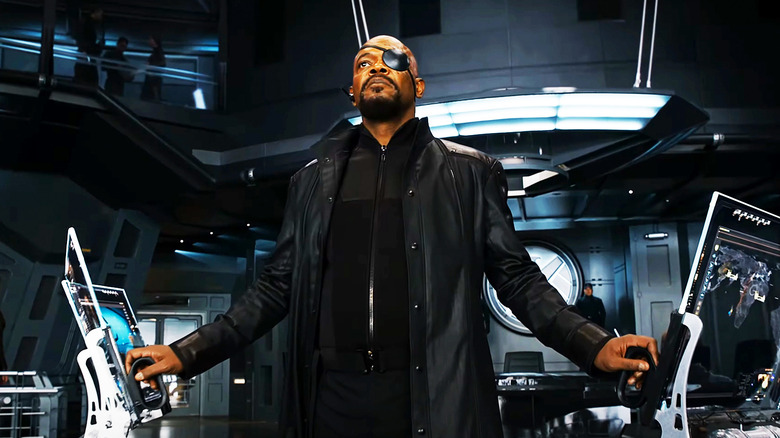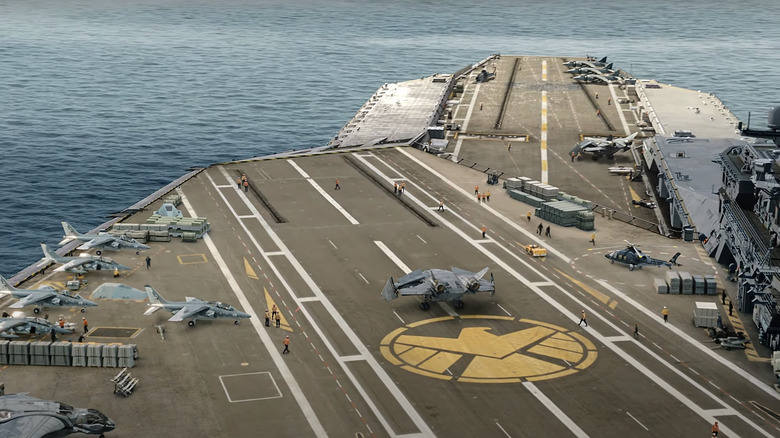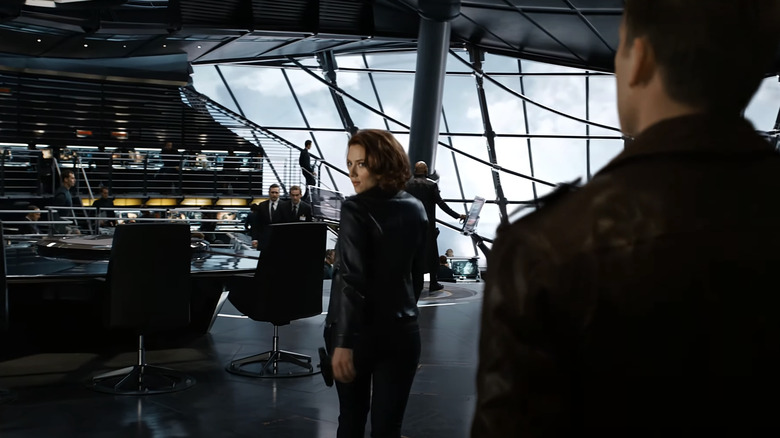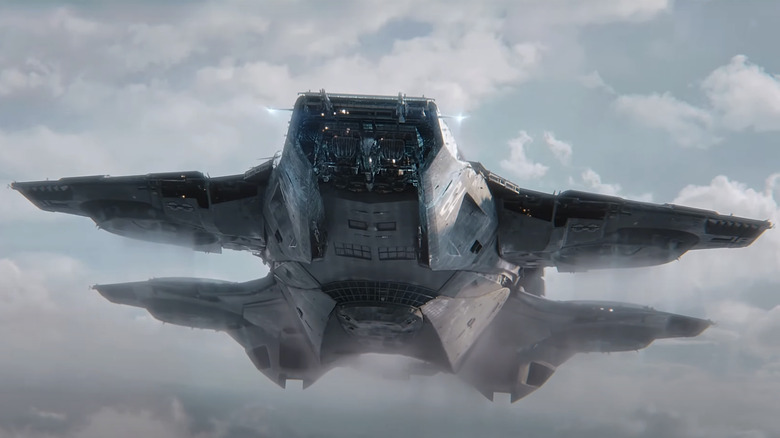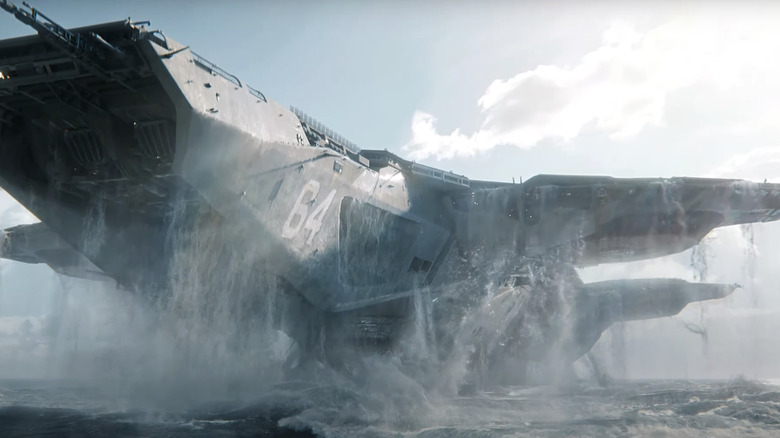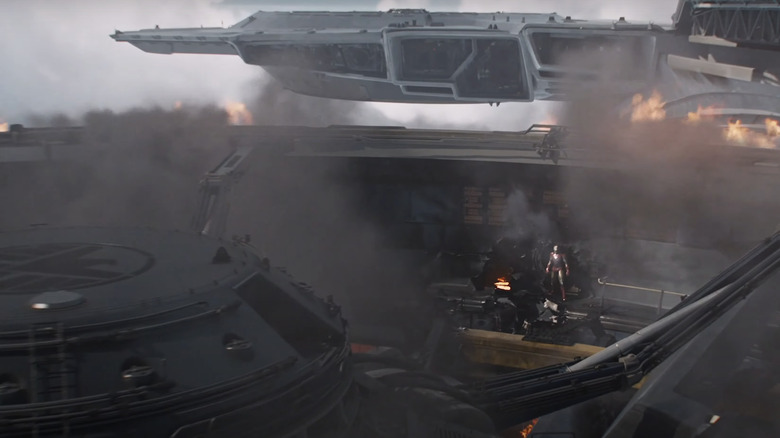Designing The Helicarrier In Marvel's Avengers Was An 'Exhaustive Process'
We may receive a commission on purchases made from links.
It's been more than 10 years since "The Avengers" redefined blockbuster filmmaking, which isn't actually all that long considering that in that time Marvel Studios has managed to go from the pre-eminent producer of box office hits to a studio struggling to overcome so-called superhero fatigue. That is to say that, with the kind of gargantuan success Marvel Studios saw, it's hard to remember a time when the company wasn't around. 2012's "The Avengers" seems like it belongs to a bygone era when the hordes eagerly swarmed the multiplex, giddy with excitement for the next superhero offering from the studio.
In a sense, the film does belong to a bygone era. 2023 was the moment when everyone realized that superhero movies needed to take a nice long break, and nothing has really been the same since. Still, it's odd to think that just 12 years ago things were so drastically different. "The Avengers" was the first mega-hit for Marvel Studios, and aside from making a whopping $1.5 billion at the global box office, it helped cement a certain lighthearted tone that would characterize the company's output for the following decade.
What's more, the film contained some of the most memorable set-pieces in the history of Marvel Studios movies. From Loki's initial attempts to steal the Tesseract from a research facility, which resulted in an opening sequence in which Tom Hiddleston's villain and Black Widow attempt to outrun a giant explosion, to the final showdown between the Avengers and the Chitauri in and around Avengers tower, the movie was full of now-legendary moments. But there was also the S.H.I.E.L.D. Helicarrier, on which several of these memorable moments took place. Bringing them to fruition, however, required some in-depth design work that was about as onerous as it gets
The Helicarrier was a key Avengers set
Between November 2010 and August 2011, more than 75% of "The Avengers" was shot at Albuquerque Studios in New Mexico, the sprawling facility that is now owned by Netflix. The production occupied six of the eight sound stages at the studios, building practical elements of the S.H.I.E.L.D. Helicarrier on several.
It was aboard the Helicarrier that Tom Hiddleston's Loki delivered what might still be the rudest line in "Avengers" history. It was also where the superhero team first started working together to prevent the giant aircraft from falling out of the sky. In fact, it was the setting of a major set-piece in the film, that saw Bruce Banner (Mark Ruffalo)'s first transformation into The Hulk among his newfound superhero cohorts, after which he wreaked havoc aboard the ship, prompting Black Widow, Captain America, Thor, and Iron Man to do their best to keep the thing afloat.
But the Helicarrier was also the setting for less ostentatious but similarly important moments in the film. We see the newly-formed superhero team bantering back and forth for the first time on the bridge of the S.H.I.E.L.D. ship, having been assembled by Nick Fury. These scenes, with a little help from writer/director Joss Whedon's comedic sensibilities, helped establish what would become the group's signature repartee.
In short, then, the Helicarrier was a key location in "The Avengers," and therefore needed to look as impressive as possible from a production design standpoint. That meant that designing the aircraft was a particularly taxing process.
Designing the Helicarrier interior
In the book "The Avengers: The Art of the Movie," concept artist and illustrator Nathan Schroeder explained how the Helicarrier was envisioned by production designer James Chinlund "to be a dramatic realization of futuristic technology that needed to satisfy a number of criteria." That criteria included a design that wasn't far removed from modern-day aircraft-carrier aesthetics, but also referred to "a design history rooted in the comic books." Schroeder added, "It should be light enough to fly, but also strong and aggressive [...] but also maintain an identity as a military vessel."
Chinlund, who was also the force behind the production crew's relentlessness on "The Batman," spoke to "The Art of the Movie" author Jason Surrell about realizing this complex vision. He revealed that the bridge of the Helicarrier was the first set he designed as a "gathering place for all of the heroes," adding:
"As the main command center of this massive battle station, I knew we would have to deliver a space sufficiently impressive. My biggest fear was that after the first look at the carrier, we would wind up in an interior space that didn't match its majesty."
The designer explained how he guarded against this by designing the ship interiors around the idea that "all of the interior chambers on the ship were suspended from the decks" This meant that the deck became a kind of giant canopy from which various parts of the ship hung. As explained in the book, "an intricate series of pipes and hangers" were used to create this unique design, evidence of which can be seen on the bridge set in the form of the "massive struts on either side of the main viewing window and at the back of the space by the Avengers' table."
The Helicarrier's underside came with its own problems
When designing the Helicarrier, James Chinlund also spoke about how he was inspired by artwork from the comic book series "The Ultimates" from 2002. The art in question depicted Nick Fury — who at one point was almost the focus of a never-realized Dreamworks movie — at a large viewing window and prompted Chinlund to design the Helicarrier with the idea of "the ultimate 'eye in the sky'" in mind. This led to the designer and Joss Whedon "pushing around several different arrangements" of the main porthole window on the bridge of the aircraft.
But finding the right placement for the porthole window was just the beginning of Chinlund and his team's struggles. The window also presented what the production designer called an "incredible engineering challenge" in that it required "a seamless piece of glass that swept along these compound curves and could support the weight of an actor and a camera and a dolly." Chinlund credits construction coordinator John Hoskins with pulling it all together in the end.
Still, even with these design challenges, Nathan Schroeder claimed that "the topside of the ship coalesced rather quickly." The underside, however, was where the real challenges arose. "It needed to have the aesthetic of a nautical hull," Schroeder explained, "and yet not appear too heavy to fly. The ship's bridge had to be located on the underside and correspond to the practical set built on stage." Matching the practical set with the designs was, therefore, one of the first challenges the team experienced. But as Schroeder recalled, Chinlund also had some grandiose visions for other interior sections of the set.
The Helicarrier hull was the biggest challenge
One of James Chinlund's big ideas for a section of the Helicarrier was, according to Nathan Schroeder, a "great wishbone hallway that would be open to the sky and provide dramatic vistas from inside." This would also be used during the attack on the Helicarrier, wherein Iron Man attempts to re-engage the damaged turbines that keep the ship airborne.
But even the great hallway and the turbines were evidently nothing compared to the stern of the Helicarrier, which was, according to Schroeder, "the most problematic and the last part of the ship's design to be fully refined." There were several technical and design issues thrown up here, partly due to the aforementioned wishbone hallway, which had to be integrated into the design of the hull itself, along with the lower decks. What's more, the hull design had to incorporate space for a launch area used by the Quinjets — much smaller crafts used by the Avengers. As Schroeder notes, alongside these considerations, the design also had to ensure the ship didn't feel "too open and vulnerable." The artist added:
"We needed to properly locate and describe the massive engines that provided forward propulsion; aesthetically integrate the wings into the body; and provide for numerous intake and exhaust vents to suggest yaw, pitch and roll stabilization."
In all then, the Helicarrier design was an impossibly complex thing to bring together, incorporating elements of practical sets while having to accommodate various story beats and project its own design language that harkened back to military aircraft while simultaneously feeling like a state-of-the-art supercraft that superheroes might use as a base of operations. On top of all that, there were decades of comics to reference and ensure the fans were getting something new yet familiar.
The Helicarrier design was an 'exhaustive process'
As James Chinlund explains in "The Avengers: The Art of the Movie," a big part of designing the Helicarrier came down to capturing the aesthetic of the aircraft from the comics. He said:
"We spent a lot of time trying to distill the essence of the Helicarrier from the various versions throughout the Marvel Universe. Ultimately, the goal was to create a ship that was simultaneously believable as a vehicle that might actually exist, and completely mind-blowing and overwhelming in its scale — a real challenge to say the least."
Still, one guiding principle seemed to help Chinlund and his team bring everything together: "Create something that looked like it could fly, that could actually exist in today's military." Even with that direction to help guide them, the final design of the carrier proved to be, as Nathan Schroeder put it, "an exhaustive process." That's evident from the images on Chinlund's website, which show how every element of the Helicarrier had to be crafted and refined, from the turbines to the wishbone hallway.
Still, it was surely worth it. Not only did Chinlunch, Schroeder, and their teams contribute to "The Avengers" — one of the best Marvel films and a movie that transcended barriers and changed everything — the Helicarrier design would be used throughout the franchise's run, representing a particularly enduring and integral piece of the Marvel Cinematic Universe.
